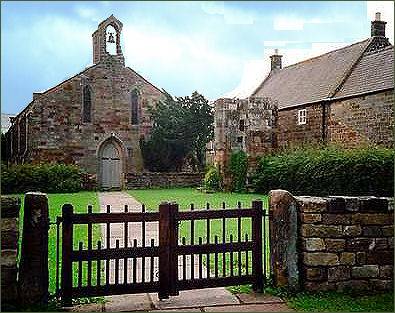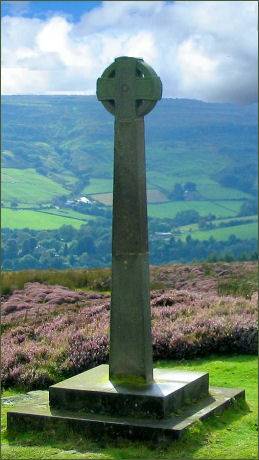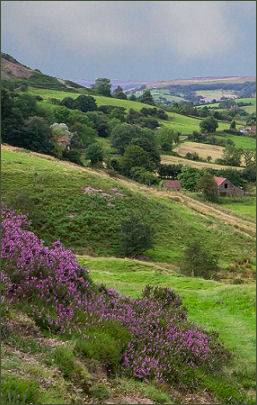Rosedale Abbey
OS grid reference:- SE 726 960

 The picturesque Yorkshire village of Rosedale Abbey is situated in the Ryedale district amid the stunning scenery of the North York Moors National Park and lies around 8 miles (13 km) to the north-west of the market town of Pickering.
The picturesque Yorkshire village of Rosedale Abbey is situated in the Ryedale district amid the stunning scenery of the North York Moors National Park and lies around 8 miles (13 km) to the north-west of the market town of Pickering.
It is likely that the village 's name has Viking origins, deriving from "Rossi", which could be either a personal name or the word for a horse. Another possible root is the word "rhos", which meant moor.
The village is built around a series of open green spaces and consists of stone houses, public houses, an art gallery, tea room, and a glass studio. 400 years ago, a group of Huguenot craftsmen practised the secret art of glass-making in Rosedale. The tradition is kept up in the village today today at the Rosedale Abbey shop and workshop.
A Cistercian Priory once occupied the site. All that remains of the building today is a staircase, a sundial and a tower that stands just outside the west door of the current church. Founded in 1158 by William of Rosedale, the Benedictine priory was inhabited by a small group of nuns who were probably the first people to farm sheep commercially in the region.
At its peak it probably only contained nine nuns and a prioress. The priory was closed in 1535 at the Dissolution of the Monasteries under King Henry VIII. Much of the buildings remained until the mid nineteenth century, when the expansion of the mining industry in the area resulted in a great demand for houses. The stone was taken to build the houses in Rosedale Abbey. Identifiable fragments can be seen in the village. The window jambs where used as gate posts in the lane by the Milburn Arms. All that remains of the abbey today dates back to the thirteenth century and consists of a pier from the abbey church, some 4 metres high, with a recessed doorway arch, an internal spiral stair and a sundial.
 The village church of St Laurence dates to the nineteenth century and stands on the foundations of the priory chapel. The medieval chapel was demolished in 1839 and a when the present church was built. An old stone seat from the medieval priory. known as the 'bishop's chair' can be seen inside, on the floor on the left, is a memorial tablet inscribed with a cross above which the name MARIA, (one of the nuns) is just visible. The pews inside the church are the work of Robert Thompson (7 May 1876 - 8 December 1955)‘The Mouseman of Kilburn and date from his early years before the famous mouse appeared on all his work.
The village church of St Laurence dates to the nineteenth century and stands on the foundations of the priory chapel. The medieval chapel was demolished in 1839 and a when the present church was built. An old stone seat from the medieval priory. known as the 'bishop's chair' can be seen inside, on the floor on the left, is a memorial tablet inscribed with a cross above which the name MARIA, (one of the nuns) is just visible. The pews inside the church are the work of Robert Thompson (7 May 1876 - 8 December 1955)‘The Mouseman of Kilburn and date from his early years before the famous mouse appeared on all his work.
The village pub, the Coach House Inn is a friendly country pub renowned for good food & drink, the Milburn Arms as a Country House Hotel. Fronted by large gardens to the front and side, the hotel incorporates 12 bedrooms, a bar and restaurant.
Dale Head Farm Tea Garden, a working hill farm tucked away at the head of Rosedale, opened to the public in 2010 and serves sandwiches, cakes, loose leaf tea, speciality teas and Taylors of Harrogate coffee.
Nearby Byland Abbey made iron in the valley from the mid thirteenth to early sixteenth centuries, an iron ore mining industry was established at Rosedale Abbey in the nineteenth century, when it was discovered that the iron ore in the valley was 45% iron. The industry saw its demise in the 1920s. The standard-gauge Rosedale Branch railway line ran round the head of the valley, serving mine workings on either side.
Rosedale is popular with walkers and offers routes for all abilities, including the old railway which continues the whole length of the valley and provides stunning views of Rosedale. The village lies on the Abbey Trail, which links monastic sites in Yorkshire such as Whitby Abbey, Fountains Abbey, and Rievaulx Abbey.
